A Visit to Finland in 1956
A student’s travels and experiences on a visit to a power station construction site by John Woodman
First published in Great Britain 2021 by Woodman Publications
Introduction
For many years my wife and children had been pressing me to write about my unusual early life. When sorting out various papers left by my parents I found three brown envelopes about ten years ago.
One contained letters and cards I’d written home from St Austell, in Cornwall where I had been evacuated in 1944 at the time of the flying bombs when I was eight. The second envelope had letters from when I was in Germany doing my National Service in 1959-1960. The third envelope had letters from Finland in 1956 where I was visiting the site where a hydro-electric power station was being built. This was as part of my studies while on an engineering course at King’s College in London.
The letters from St Austell are included in a book ‘Growing up in Challenging Times 1935–1948’ which I published in 2015. The letters from Germany which I typed up about ten years ago could form part of another book. But for some reason, apart from glancing through the ones from Finland, I had not read them since I sent them home all those years ago. My family has again been asking me to type them up and this is the result.
Reading the letters jogged my memory of my two months in Finland and the happy time I had there in what were very different times. For instance it took me five days to get there and eight days to get back taking three days to get to Helsinki and going via Oslo! There were three other students besides me, one from Paris, one from Salzburg and one from Sarajevo. There was also a young Finn and we all spent a lot of time together. I was twenty and the others were the same or a little older.
I spent two months in the north of Finland where the company Oulujoki Oy was building a power station at Utanen. Oulu is the name of the town at the mouth of the river on which the power station was built; ‘joki’ is Finnish for ‘river’ and ‘Oy’ is Finnish for ‘Company’. Hence Oulujoki Oy.
The letters and post cards sent home in 1956 are typed in normal type. Any additional information from my memories is in italics. I sent home lots of postcards when I was on the move. Much of the information was duplicated in subsequent letters so I have only typed up the information on the post cards where it provided extra details. I also brought back details of the project which they had given to me. All this is in ‘Part One - 1956’ which excludes anything that I learnt subsequently.
I had a number of photographs given to me by the other students when we were actually at the plant. They were mainly of people with just one or two of the plant itself. I decided to write to Fortum Power and Heat Oy, the company which now owns the six plants built by Oulujoki Oy, asking if there were any photographs taken during the construction of the plant. To my great surprise I was sent back pictures which were actually taken while I was there. I was also asked if my story could be shared on its website. I then got an email from an organisation which is currently working on a project to get the whole system of power plants declared a UNESCO World Heritage Site which also wanted permission to print parts of my book. All the pictures of the construction site are from 1956 or before.
My passport provided information about the currency regulations at the time which will be surprising for younger readers and bring back memories to older ones who travelled abroad after the war until the 1970s. For full details see chapter on ‘My Passport and Currency Restrictions’. It also provided confirmation of my dates of travel with the stamps showing when I passed from one country to another and my visa and working permit for Finland.
Acknowledgements
I am very thankful that my parents saved the letters which I sent back from Finland.
I am also very grateful for the help given to me by three contacts I found in Finland which I believe has made this book more interesting and given it an extra dimension.
Firstly, Paula Parnanen who is the Communications and Marketing Manager of Fortum Power and Heat Oy. I was not only given permission to quote from its literature, including an update on the power plant from November 2020, but also to include a number of excellent photographs many of which were taken in July 1956 while I was there.
I also include extracts from two items. The first is from a leaflet given to me by Oulujoki Oy, called ‘Power Plants on the Oulu River’, while I was on site in 1956. The second is from a comprehensive account of the history of the whole project and the six power stations built by Oulujoki Oy called ‘Power on the Oulu River’ dated 1953 which I received this January.
Secondly, Pekka Elomaa, Architect, Project Manager, Council of Oulu Region who acts as Project Manager on the Finnish side of the VekuVaku project. The VekuVaku is a cross-border EU project. VekuVaku stands for, in English, ‘The cultural environment of hydropower’, and has the ultimate goal to make the Oulu River power plant chain and residential communities part of a UNESCO World Heritage Site. I am grateful for his enthusiasm and help.
Thirdly, Helena Hirviniemi, for her article ‘The Oulujoki Power Plants and Communities’. This gives an overview of the whole project of which the Utanen hydro- electric power station is a part.
I brought home or was sent many photographs from the three other students who were with me some of which are included and I have in addition included two or three pictures given to me by people working at the power station site. Also included are other pictures and post cards which I brought or sent home where I cannot trace the origin.
I must also thank those of my family who have read the proof, pointing out errors in my typing and querying anything which is unclear. This is most important as I am publishing the book and the printers will reproduce it exactly as I have sent it.
John Woodman – May 2021
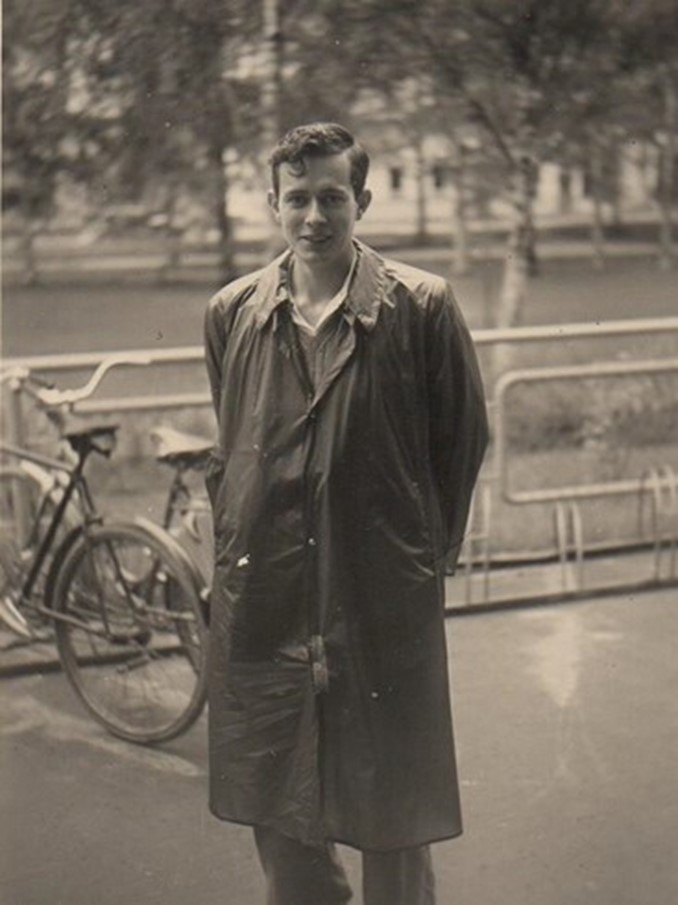
In Oulu. Photo: Mr John Woodman’s personal photo collection.
Preparations for my visit
In 1956 as part of the engineering course at King’s College in London students were placed with engineering companies in the UK and other European countries. We were given a list to choose from. Students could also find their own placements if they wished provided the College gave its approval. I spotted an opportunity in the north of Finland where a hydro-electric power station was being constructed. I made this my first choice and found to my surprise that no one else had made it theirs.
I had to make my own travel arrangements which were hurried as I had only received the final details shortly before I was due to leave. I visited the Finnish Embassy the day before I was leaving to get a visa and a Working Permit. According to the visa I had to enter Finland before 25th August and stay no longer than 90 days. The only English on the Working Permit stated:
‘This Working Permit does not authorize any transfer of currency without the approval of the Bank of Finland. The bearer of this passport must obtain a Finnish taxation book and produce it to his employer.’
On the day of my departure I left Halliday Hall, my hall of residence in Clapham, to collect my travel tickets, travellers cheques and Finnish currency. I went to the Thomas Cook office in Gracechurch Street, London EC3, near Monument Station on the Circle and District underground lines. Don Thompson, one of the Encombe boys who had been evacuated with us to Dorset at the beginning of the war, worked there. (He had also got my tickets when I had visited The Netherlands and Germany at Easter in 1955.) Besides my tickets which Don had ready I bought travellers cheques and 7,200 Finnish Marks at a cost of £9.
In addition to what was in my passport I was provided with a card, sent from Finland, asking for people and organisations to give me help if I needed it in Finland. However, everybody in Finland was so welcoming and helpful I never needed to show it.
The journey to Finland
The letters and post cards sent home in 1956 are typed in italics. Any additional information is [in normal type].
Monday 2nd July 1956
Dear M. and O.B.,
I have reached Utanen.
Perhaps you would like the story of my journey. The first incident happened in London. I had done everything and was in Monument Station having got my travellers cheques. My case I had deposited at Charing Cross (now renamed Embankment) so I had to get there before Liverpool Street. The time was about 1.35 pm. Having got round to Mansion House in the usual Circle Line fashion the train stopped for five minutes. On going into the tunnel we waited another seven minutes and thereafter five minutes in each station and each tunnel to Temple. I was getting a little worried about the time now and considered the awful possibility of being stuck in the tube between Temple and Charring Cross. So I leapt out of the train and decided to run for it – needless to say the light immediately changed to green and I jumped in again hoping my luck had turned and the train went through slowly to Charing Cross without a stop, the time being 2.20 pm. I was told that there had been some kind of breakdown at Westminster.
My luck held as I rushed to collect my case and proceeded to Liverpool Street non-stop – leaping in a train at Strand (now renamed Charing Cross) as the doors closed. On arriving at Tottenham Court Road, I changed platforms and caught a train which was just entering the station. I reached Liverpool Street Station at 2.40 pm and so had about twenty-five minutes to spare. I had a straight-forward journey to Harwich, boarded the ship and found my berth. It was very comfortable – there were four bunks one of which was unoccupied, two basins and four potties. I went to bed early and had a good night’s rest despite the noise of the engine and found that the boat was rocking somewhat. I got up about 9.00 and shaved.
Then I decided to resume the horizontal as I felt queer. A West Indian chap lent me a magazine or two – he happened to be in the same room – and I looked at these for an hour or two deciding breakfast was not the thing. A steward came round and asked if we were all right and a continuous commotion suggested others were not in such good trim as I. I got up later and felt very well and not at all disturbed by the motion of the boat. On reaching the deck I did not see the bloke I had spent the previous evening with and who was also going to Finland. The supper we had had, had not been very good, we could eat as much as we wanted but there was nothing filling and we polished off the bread for four people as there was no one else on our table for four.
On strolling about deck I found the West Indian chap and another bloke who was coming on the same scheme i.e. Roger. He was studying geology and was going to work at a mine. Roger and I decided to have lunch on the train as it was still very choppy. Another bloke, namely Chris, turned up and explained that he had been sick. There was not much of a customs examination at Esbjerb and we got on the train and found that there was no dining car but we would have to wait till we were on the ferry from Nyborg to Korsor. The scenery was not much and as expected i.e. flat but knobbly. When we got on the ferry we thought that we might as well wait to eat until we got to Copenhagen.
At Copenhagen we had a good meal in the station and had a brief look round the city before we took the ferry to Malmo. Chris stayed behind because he was taking a later train. Here we met two New Zealanders and kept with them until we got to Stockholm. On the Swedish railway the seats deteriorated and were wood with very little padding - the Danish being as good as the worst on the Southern Railway. We left Copenhagen at 9.10 pm and were overnight on the Swedish line. Needless to say I did not sleep very well as the seats were very hard and I might have slept better had not a ticket collector woken us up at 1.00 am and 3.00 am to see our tickets.
At Stockholm we arrived at 8.45 am and said goodbye to the New Zealanders and went into the city to get a meal. When Roger and I reached a likely café we went in and sat down. At the next table was a woman somewhat dumbfounded at the menu after which she looked at the waiter and said “I want bacon and egg” in a strong American accent. We found the ship to Helsinki and left at noon. The fjord to Stockholm is long and we wove about in it for about three hours. It is impossible to say how long as we were never far from land and continually weaving in and out of islands which were very low lying and covered with pine trees. I noted that on the boat notices were in three languages – Finnish and Swedish (the official languages in Finland) and English. The meals on the boat were very expensive, i.e. 14/- approx. (70p), but you could eat as much as you wanted. So we waited until we were very hungry and then had one large meal. A couple of Americans who sat with us did the same. We reached Helsinki in the morning at 9.00 am and outside the customs I said ‘cheerio’ to Roger. Now began a time of ups and downs, fortune changing very quickly.
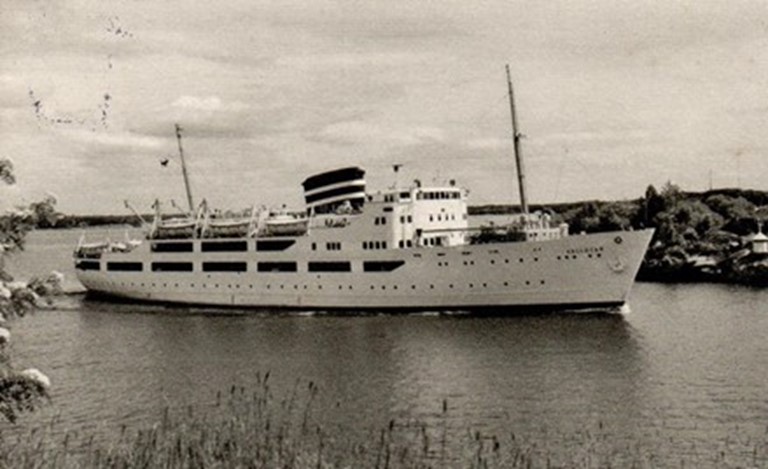
S. Aallotar – My ferry to and from Helsinki. Photo: Mr John Woodman´s personal photo and postcard collection.
It started all right. [I visited the headquarters of Oulujoki Oy (Oulu River Company) where they said I had to make my own way to the site on the Oulujoki River at Utanen in the north of Finland. It was here that the company was building a hydro-electric power station.] I was told that I could get to Oulu for about 2,000 Finnish Marks (£2.22) by train or 4,000 Finnish Marks (£4.44) by air. So I chose train and decided to go to the railway station and leave my case. I had found a useful booklet and took a taxi as the station was some way and the fare came to 3s 6d (17½p) which was not bad and there is no tipping in Finland. Having left my case I found a travel bureau and after some difficulty paid my fare and received my ticket. The fare to Nuojua was very cheap - £2 9s 7d (£2.48). The trains here are wood burners. Utanen it appeared was not on the railway line but some three miles from it. The travel bureau telephoned Oulujoki Oy and they said that I had to get off at Nuojua. I had to wait till 6 pm for the train so had about eight hours to wait.
I wandered up to a bookstall and to my surprise there were copies of the Daily Mail, the Daily Express and Herald and several English books. It is easy to see how foreigners pick up some English as adverts like ‘Guinness is Good for You’ which abound in the city and on looking in shop windows many of the goods have English labels – i.e. ‘Kellogg’s Corn Flakes’ etc. with no attempt at any Finnish at all. On looking in another window I saw some ‘Education World Globes’ which said on the packet what a good thing it was to have one and so learn the Geography of the world. The fact that it was in English did not seem to trouble the people although the names of the countries are very different in Finnish: Austria – Itavalta Estonia – Viro France – Ranska Germany – Saksa Netherlands – Alankomaat Russia – Venaja Sweden – Ruotsi. The finishing touch was a bright maroon van which said ‘Yes Sir! Boston’s Cigarettes are sure the Best!’
[Apparently the first set of traffic lights in Finland had just been installed in Helsinki and lots of people stood around watching the lights change colour. I needed to go to the loo so having checked the signs on the doors I opened what I thought was the right one and was immediately in front of a kiosk with a woman sitting at a desk. Before I could back out thinking that I had made a mistake she waved me forward. As I reached the kiosk she pressed a button and a ticket jumped out on to her desk. It was like getting a ticket when going to the cinema. Having paid I was about to go on to the right when she pointed to my left and on the wall at about shoulder height was a loo roll from which I was to take sufficient sheets. As I walked inside it was a large room with a row of wash basins on the left, opposite on the right was a row of toilets. There were partitions up to about waist high but otherwise quite open. There was a woman cleaner mopping round but otherwise men were getting on with it.]
When I went for the train all I could see were sleeper coaches. Having walked the length of the train and shown my ticket to a porter he pointed to one of them with Oulu on it and I got in. Now began the most uncomfortable railway journey I have experienced. There were pull-down seats in the corridor of the sleepers but it did not seem right somehow. The ticket inspector was not satisfied with my ticket and expected something more and was nattering with the passengers. Then someone informed me that there were normal carriages further up the train. I had obviously boarded the train before they came in. So with a heavy case I walked along at least eight coaches. The connecting links were a little old-fashioned with just a hand rail in the open air. All the seats were taken so I sat on my case in the corridor. I then realised that in the hurry I had left my coat back in the other coach! Having retrieved it rock bottom was reached when I knocked over a bottle of orange squash which had been left in the corridor.
Hardly had I done this, however, when two blokes approached and one said in a Ludwig Koch manner “Are you a Britisher?” [Ludwig Koch. was often on the wireless and spoke English with a very strong German accent. He came to England in 1936 as he was worried about his safety because of what was happening in Germany. He was interested in natural history and especially in the sounds made by animals and birds. He was often on the BBC in the 1940s and 1950s where he played his sound recordings. In 1953 HMV produced a record of his recordings with the title ‘Songs of British Birds’. He never lost his very distinctive strong German accent.] I said “Yes” and to my surprise he said “So am I” and pulled out an Australian Passport. They led me to a carriage and gave me a seat. The conditions on the train were too difficult to describe. The train kept stopping and people came in to claim odd reserved seats but this was difficult as others had moved the reservations about so that none of them now corresponded to their seat numbers.
[As there were not enough seats people changed from sitting to standing from time to time and nearly everybody had a chance to sit down at some stage. Ludwig said it was the right thing to do and that people who were able to and did not were unfriendly. The train stopped for several minutes at some stations and one in particular was Tampere. Most people got off here including Ludwig and his friend. Not knowing what was happening or when the train was going to leave I stayed on the train. Suddenly after about twenty minutes there was a rush of people from all directions, including Ludwig and his friend, getting back on the train. He said that they had got off to have some refreshments. It was getting late but no one seemed to be interested in sleeping and they were all jabbering away to each other and this continued through the night.]
It never got dark at all, the sun setting and rising in about an hour and a half. The seats were wooden with some thin carpet stuff tacked over. Fourteen and a half hours later I reached Oulu. The train was running 20 minutes late. As there were only ten minutes between the timetabled arrival and departure of my connection I was a little worried but it was all right as my train was waiting.
[While changing trains I noticed a couple of wood-burning steam engines. With their large funnels they reminded me of films I’d seen in the mid-west of the United States. Steam engines back home were all coal fired. Unfortunately, I had no time to have a closer look at them. Wood was the obvious choice as timber was the only natural product available in quantity.]
I arrived at the station Nuojua to be told in signs that it was the wrong one. I should have got off two stops earlier. I carried on a conversation of signs and broken German with the man in charge who rang up the company. Someone on the phone spoke to me in English and said that she would send a car.
I was taken to an office in the car and introduced to the secretary who spoke very good English. After a preliminary talk she asked me how much my fare was as it would be refunded i.e. from Helsinki. When I told her she said “But that is second class and you should have come first class and so the first class fare will be refunded to you together with some other money for the time spent on the journey.” So I was given 6,880 Finnish Marks. At the official rate of exchange of 900 marks to £1 this is about £7.10.0 (£7.50). I felt that I had earned it though. She then gave me some dinner, very welcome after a seventeen hour train journey. I had been unable to get any food on the train although I drank some water which was provided in each carriage. I was then driven to Utanen.
Next instalment soon but I am quite O. K. Please would you send me the following:
- Pencil
- Some mosquito stuff – before and I left the other at Halliday Hall in a special place where I would not forget them. That’s life! Insects have not been very troublesome as yet but things may, of course, get worse.
Cheerio for now, John
[For some reason I referred to my father occasionally as‘Odd Bod’, hence ‘Dear M. and O.B.’ My Aunt Edith often told me off for using slang or colloquial words, for example, using ‘bloke’ or ‘chap for a man. Surprisingly, however, she said ‘bread-basket’ for ‘stomach’!]
Getting settled in at the construction site
[On arrival I was shown to my room. It was early afternoon and I was extremely tired as I had been travelling for five days and had not had any sleep on the overnight journey from Helsinki.]
Saturday 7th July 1956
Dear M. and O.B.,
I trust that things are all right at home and that you are having good weather. Please keep me informed of cricket developments – expect Surrey have lost many matches. [Surrey had won the County Championship for the last four years so this seems a bit pessimistic.]
I expect that you wish to hear about my doings of the last week so here they are. As you can well imagine I slept well on the Saturday afternoon and night. [I woke up and it was broad daylight. I jumped out of bed with alacrity, looked out of the window, it was bright sunshine and then I looked at my watch. It was just after 2.00 am. Well, I was near the Arctic Circle!] I got up at about 8.30 am on the Sunday not knowing what I’d find. A description of my room would be probably to your liking. Size 14’ x 8’. Furniture 1 bed, 1 upright chair, desk-bookcase one side, drawers the other, 1 sink, 2 high cupboards – one with shelves and one without - about the same as my cupboard upstairs - and one small cupboard.
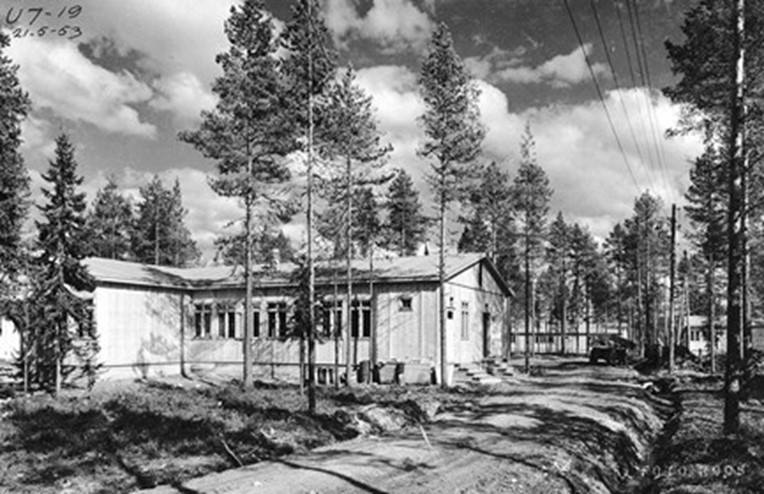
Builders’ restaurant, a typical wooden building at the site. Photo: Fortum Oyj photo archive (U7 19-21.5.1953).
I live in a superior wooden hut which has sixteen inhabitants altogether. Most Finns live in superior huts up here and indeed all at Utanen. I share the place with ‘housemasters’ to use the literal translation - a superior type of foreman. Utanen owes its existence to Oulujoki Oy and quite a lot of people hang out here. 2½ miles away is Utajärvi, a town of some 6,000 bods. There is a general store and a pop-shop there. [I used the term ‘pop-shop’ because no alcoholic drinks could be sold anywhere nearby. The nearest place was Oulu which was about 60 miles away.] It is difficult to buy some things in Finland as shops are few and far between with the nearest in Utajärvi.
So, on the Sunday morning I waited for things to happen. At 12.00 the cleaners came to make my bed and they started things off. I had made a couple of sorties earlier but had not discovered anything of note. Five minutes later a bloke knocked at my door, came in and shook hands. He signified that I was to eat and we went to the village mess room. The housemasters have a small room of their own and this is where I eat. I spent most of the afternoon being shown round and drinking coffee in various people’s rooms. I had another meal at 4.00 pm and at about 8.00 pm I was invited to play a game of handball which is quite popular here. [One evening I was asked if I would like to play darts. We went out and fixed to a tree was a target just like one used in archery. We stood about eight yards away and each threw three arrows at the target. The scoring was as for archery. It took a while to get the hang of it but I improved quickly.] After having coffee with one of the chaps who could talk German I went to bed.
[After the 4.00 pm meal I had another try to find the loos. My little English/Finnish dictionary had proved to be very useful. So I approached someone and pointed to the word ‘lavatory’ and he pointed out a very large hut. I hurried over and went in. There were lots of people washing and showering and having walked right round with people giving me puzzled looks I came out. I realised that it was just what the word originally meant – washroom. It was at this point I noticed someone walking to an old hut about 50 yards into the forest. He went into the hut and in a few minutes came out and walked back. I thought that I would investigate and on nearing the hut I could make out on the door in large letters ‘WC’ (abbreviation for Water Closet). Ongoing in I found that over a six foot deep trench was a wide plank with about five holes spaced out to sit on. It was not a place to linger so I did my business and left. It was very similar to the loos when I went on camping holidays with the school scout troop. One of the first jobs on arriving there was to dig trenches and erect the tents around them.]
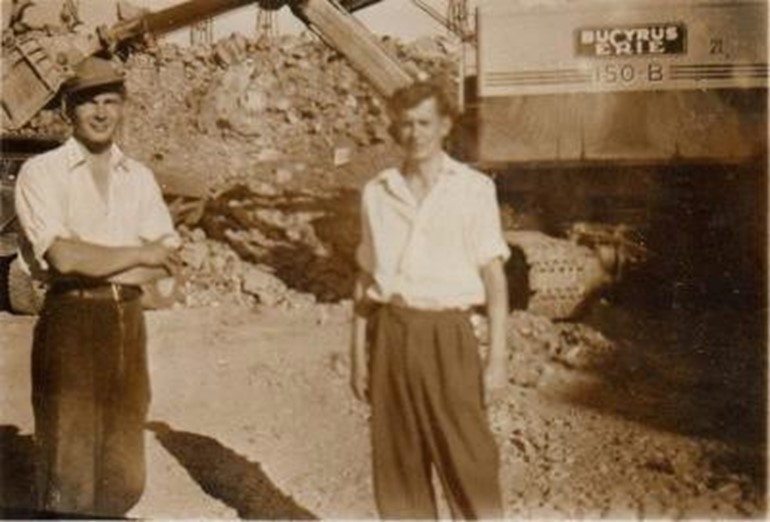
Rayner. Photo: Mr John Woodman’s personal photo collection.
On the next morning I was shown round the power station which is being built here and in the afternoon I was taken some 8 kilometres down a channel [the tailrace] which is being dug for the power station. All through last week I have been working down there from 2.00 pm – 10.00 pm and on Saturday 10.00 am – 4.00 pm. I was working with a couple of housemasters – one of them, Rayner, a young engineer and the other, Tuli, a merry chap of thirty. Rayner speaks very good English and Tuli some.
Each evening we have a bathe in the river – it was surprisingly warm. [It was warmer than bathing in the sea on the south coast of England.] The food here is quite like at home. They drink milk at all their meals and have potatoes cooked in an approved fashion. Meals here are if anything slightly cheaper than in England. One or two things are markedly more expensive e.g. one medium sized tomato – 9d (3¾p).
There is much more farming here than ever I thought there would be – much forest of course. Meals are at odd times, 10.00 – 11.00 am and 4.00 – 5.00 pm, both being a dinner kind of meal. It hasn’t got at all dark here since my arrival and it isn’t merely a question of where the sun is, when it is below the horizon there is much evidence of it. I find it a little difficult to sleep. It is not at all cold and I don’t often need a blanket. In the middle of the day it is sometimes very hot.
Monday 8th July 1956
Saturday evening I went to a dance with Rayner and had quite a good time. Rayner’s father is the station master at Utajärvi. Yesterday I went there in the evening and we played canasta. Today they did not give me anything to do and tomorrow I am going to work in the Concrete Laboratory. (I still get my 1,520 marks though.) Incidentally, I have more money now than when I left England a fortnight ago and I’ve not been paid yet. Today a Yugoslavian student, Marko, arrived and I shall be going to work with him. He speaks German and a little English.
P.S. Please send a German dictionary of some sort as I may have to carry on some conversation in the language.
Cheerio for now, John
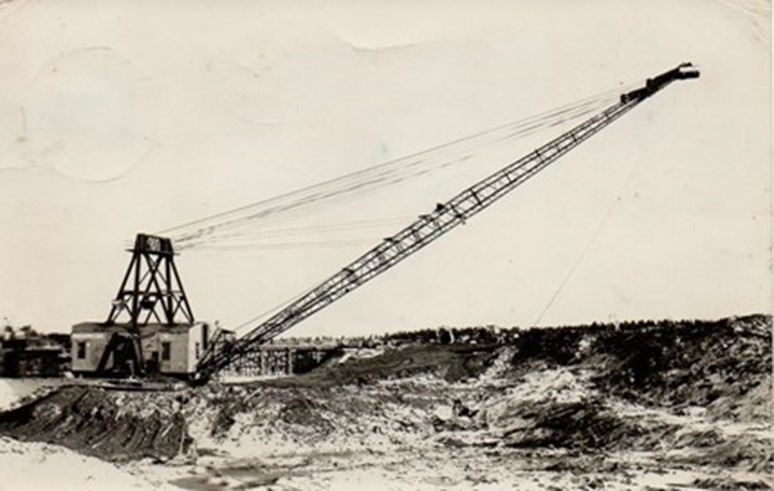
The largest crane working in Scandinavia. This Post Card of the crane was sent from Utanen to my sister Pamela who had been complaining about the midges when she had been on holiday in Scotland. The midges there are very troublesome, just as I had found them in the North of England and Wales on scout camping holidays. I wrote: The midge sort here are very good and don’t trouble me much. This crane is the largest one in Scandinavia and I was working just by it in my first week. The weather here is very good – i.e. not too hot. Mr John Woodman´s personal photo and postcard collection.
[From time to time I went with Rayner on the back of his motor bike. I also had one or two excursions on my own on a borrowed bicycle. There are no tarmac roads up here. The dirt roads are wide enough for two lorries to pass each other but only the middle of the road is to a good standard. There is not much traffic and when vehicles meet they drive to their side and pass each other very slowly. Otherwise they drive straight down the middle. As far as cyclists are concerned, if something is coming from either direction they immediately dismount and get right off the road. They are very dusty and service vehicles drive along regularly spraying them with water. Lorries particularly were throwing up a lot of dust as well as small stones in their wake. For cyclists the roads were very uneven and bumpy. You can well imagine the conditions did not make it very pleasant.]
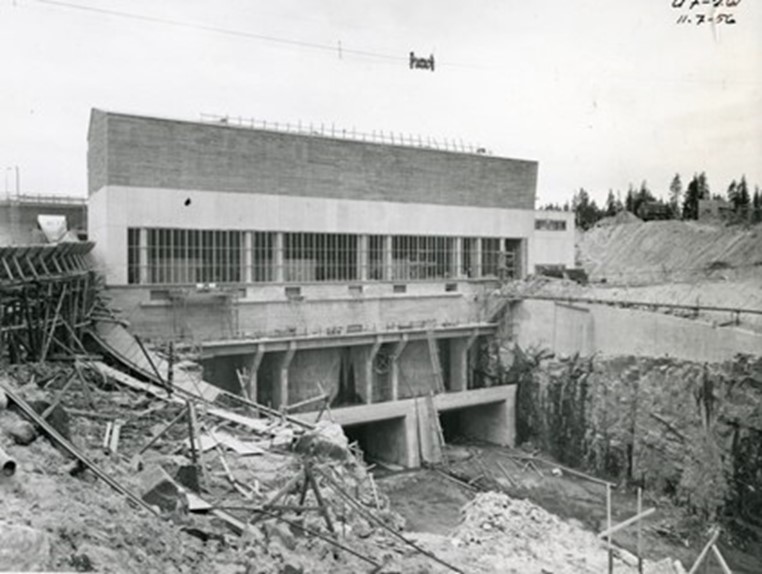
The power station and start of the tailrace. Photo: Fortum Oyj photo archive (U7 261 - 11.7.1956).
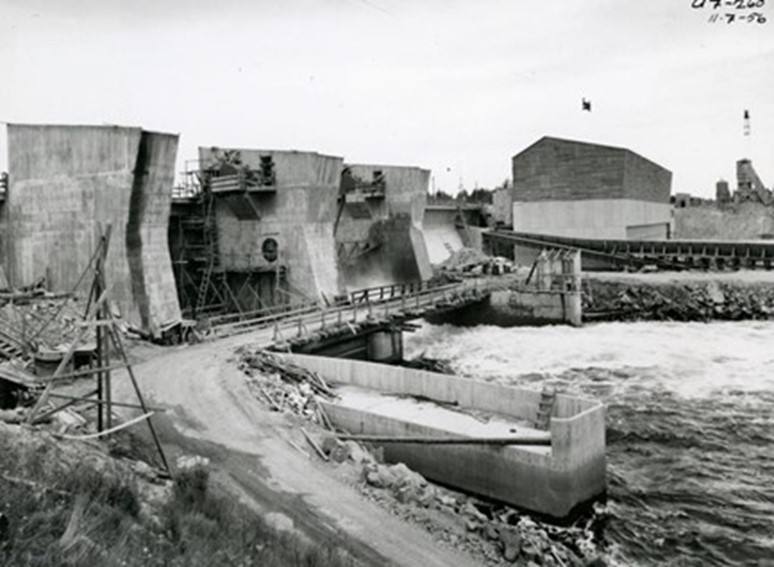
The dam on the left and power station on the right Photo: Fortum Oyj photo archive (U7 260 - 11.7.1956)
Two more students coming
Saturday 14th July 1956
Dear M. and O.B.,
Thank you very much indeed for the letters, different from the Finnish, German, Swedish, French and Yugoslav which appears all round me. I spend most of my time with the Yugoslav bloke who is a good sort. He doesn’t know much English and I don’t know much German but he speaks German perfectly. We are rapidly learning some of the others’ languages. I have spent much time learning German and Finnish and teaching others English. A French bloke is coming soon so I have asked Pamela, (my sister), to send some French things. An Austrian student arrives this weekend.
The weather is still very good. I have taught the Yugoslav, his name is Marko, to play crib which he picked up very quickly but I nearly always win. We also play chess and he nearly always wins.
Monday 16th July 1956 - today the Austrian student, Willie, came and he is a very good chap as well. The weather is still very good.
Cheerio for now, John
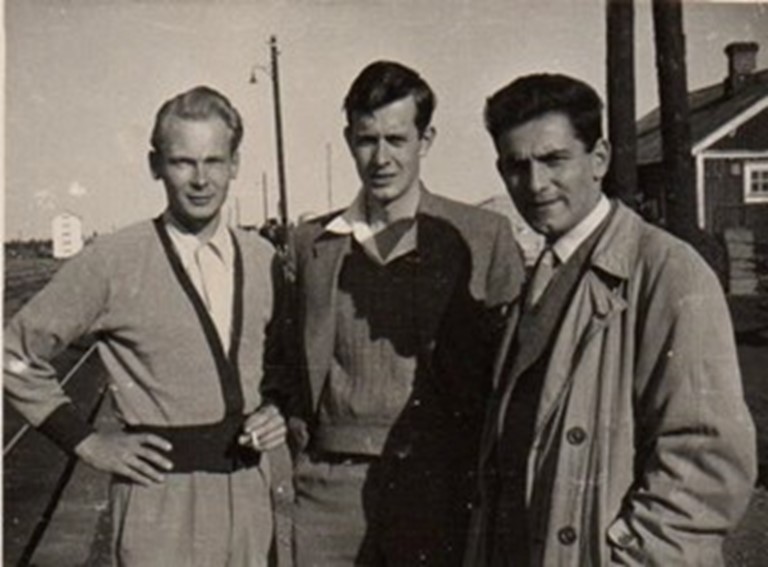
Rayner on the left, Marko on the right. Mr John Woodman´s personal photo collection.
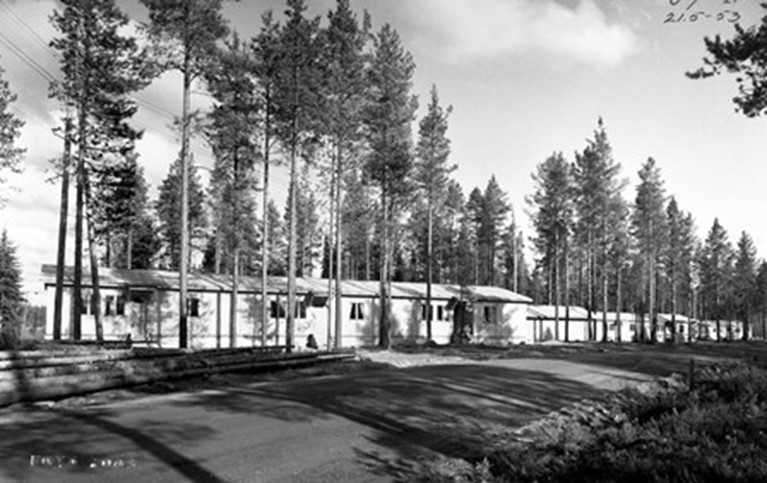
Workers’ accommodation. Photo: Fortum Oyj photo archive (U7 21 - 21.5.1953)
Life continues on and we all have saunas
Monday 23rd July 1956
Dear M. and D.,
So what is happening here? We are continuing on in the same fashion and I am learning quite a lot of German. On Saturday we three, myself, Marko and Willie with Willie’s friend from Nuojua (he is studying electrical engineering) and Rayner went to a dance in Utajärvi and had quite a good time. Willie’s friend Gethert had a room in Utanen for Saturday night but when he went to catch the bus yesterday he found that it did not run on Sundays and so he had to spend the night in an armchair.
I got my first pay packet last Wednesday and it was 19,000 Finnish Marks or £21 2s 3d (£21.11) approximately. Please will you forward my address book if you can find it and the addresses of the Dutch and German people. [My mother and father had met them in Switzerland when on their Silver Wedding holiday in 1954 and I had visited both families in the Easter of 1955.]
Thank you very much indeed for the newspaper cuttings they are just what I wanted. [They were the details of the test matches against Australia and Surrey’s county games. It was the year that Jim Laker took all ten Australian wickets in their game against Surrey and a feat he repeated when they played England later! When I told people here they could not understand how a match could take five days.] I’m afraid that I lost the letter in which they came. I cannot think what happened to it and I hope there was nothing important in it.
I’ve been having a few saunas – the Finnish steam bath. Here is the full story. Marko had had one and had come out like a boiled lobster so I decided not to have any. Last Tuesday Willie had one just before tea. They have steam baths in Austria apparently and at tea he mentioned the fact and so we talked about saunas. The housemasters who have tea with us told us that the best saunas had a temperature of 120° C and informed us that it did no harm as the skin protected the body quite well. I told them that it was better to swim in the river at which they were very shocked and after a little the talk drifted on to other matters.
Anyway at 6.00 pm two of the housemasters arrived and said that we must go to the sauna. They only spoke Finnish but the word sauna and impelling gestures left us no choice. Willie had to have another one and they would accept no excuses so off we went. It was pretty hot and I lost two kilos by the scales. Now about three times a week various housemasters call and take us to the saunas. I think poor Marko suffers the most. The ones we have only have a temperature of 100° C. I must stop writing now as I must catch the post.
Love from John
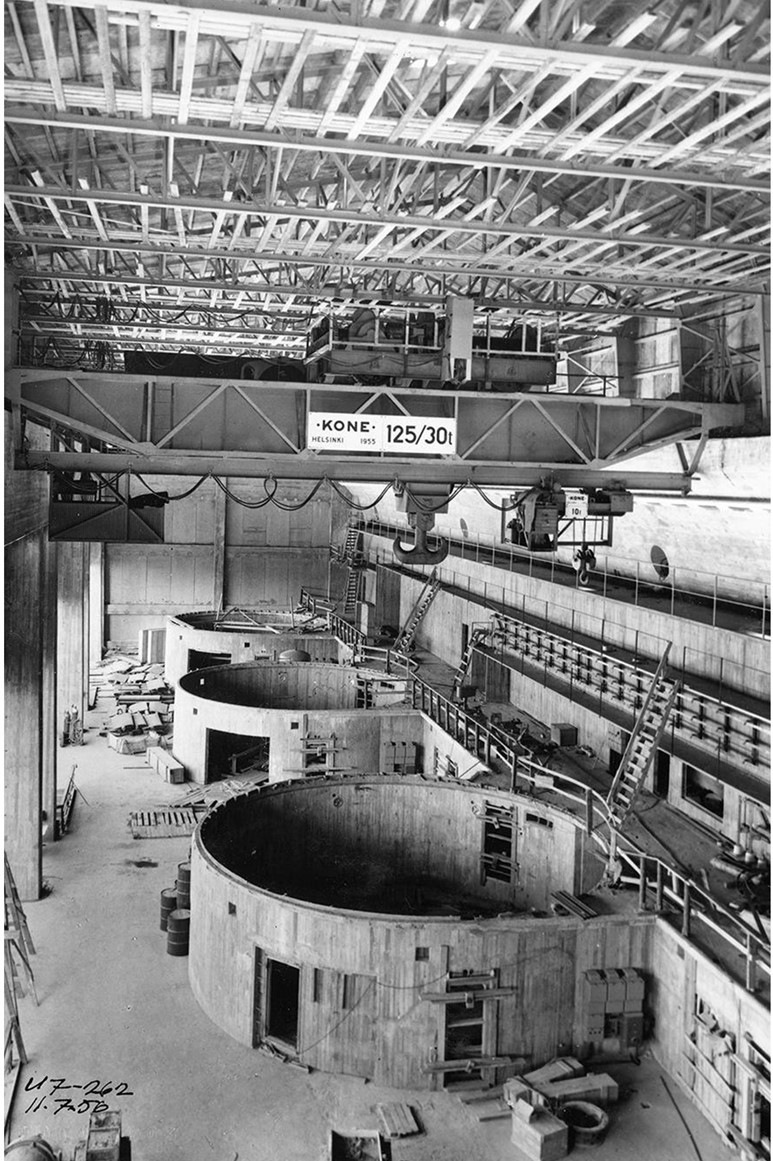
Inside the power plant Photo: Fortum Oyj photo archive (U7 262 - 11.7.1956)
Correspondence and drink problems on site
Friday 27th July 1956
Dear M. and D.,
I have not unfortunately received the mosquito stuff and the pencils. It seems that the powers that be have decided that they will not let me have them. Since my last letter I have received the German dictionary and the French things. The German dictionary is a very good one but I am afraid that the French student, Robert, has been directed elsewhere.
Thank you very much indeed for the cricket cuttings. I enjoy reading them very much and I hope Surrey keep going. Could you please send me a map of G. B. of large size. Willie is thinking of coming to England next year and I wish to show him the best places to go.
The weather is still good. I had a bathe in the river yesterday and I have also had one or two more saunas. I do my own washing. We don’t do any work here – we just watch other people working and wander round the site seeing things. It is very interesting.
I was interested to receive your letter of 20th June. Why didn’t you give it to me when I was in England? [ It could have been posted to me at my hall of residence and I would have received it before I left for Finland.]
I may as well tell you about Finland at its worst – I expect that it’s the same in all countries. Here at Utanen we are well out of the way on the whole and the firm pays high wages to attract labour. When the men have it they have nothing much to spend it on and so some of them get drunk at weekends. Now the Finns are very hospitable whether they drink or not and here comes the difficulty for us. Luckily all the housemasters are all very good chaps and we spend much of our time with them.
But three or four times men have visited us who have had too much to drink bringing bottles of beer and strong wine etc. The thing we do in such cases is to drink some beer etc. and after an hour to say – or rather indicate that we now have to go elsewhere. The worse time we had was with one man who found some cards on the table. He examined the cards carefully and indicated that we must play. We played one or two hands of pontoon which was very interesting to look back on. We were so placed that it was easier for him to collect the cards than anyone else and I noted with interest that before he dealt he put low cards on the bottom of the pack and high ones on the top. He then brought out with a flourish a 100 Finnish Mark note i.e. 2s 3d (11p). When I say ‘we’ I mean Marko and me as Willie was elsewhere.
We examined the note with interest as if it was a rarity – it was needless to say a common sort of note. By way of return I showed him one or two English coins. We then played the hand for which the 100 Finnish Mark note had been brought. We both lost not very surprisingly as he took some low cards from the bottom and then a high one from the top so that we both bust. I noticed though that an unobtrusive moment he removed the note and we thought that was that. Before my deal I shuffled the cards very thoroughly much to his distress and we played until it was again his deal.
He again put low cards on the bottom and high cards on the top and with a flourish produced a 50 Finnish Mark coin i.e. 1s 1½d (5½p). We pretended not to see it and he put the cards for Marko to cut. He then neatly put the cards back to their original position and we played. I was not very surprised when I bust. I had 13 with two cards and you have to have at least 15 to stick. He then brought a king from the top of the pack with an extra flourish so I bust. He then pointed to the coin and so there could be no mistaking his meaning. We said “ei! ei!” (no! no!) and “huono” (bad) and with much disappointment he withdrew his coin.
Marko then indicated to me that it would be good if all the drink was gone so we drank ours very quickly – it was very strong. We noted that although at the beginning he had drunk quickly he now drank very slowly. Having finished the drink it got round to his deal again and so with what must have been his last hope he produced a 5 Finnish Mark coin (1d). We again said “ei! ei!” and after the hand we stood up and pointed to the clock. Then we got outside with him and we shut the door. As we went out he had us one on either side by the arm. I think he was too drunk to do much but I held on tightly to my wallet just in case. Fortunately he met a friend in the corridor – I say friend but the man did not seem at all pleased and we disappeared rapidly. Afterwards Marko and I had a good laugh about it.
[Another time one Sunday morning at about 8.00 am there was a knock on the door. On opening it a man came in with half a bottle of spirits and two glasses. He poured out two glasses and raised his glass and said the equivalent of “cheers” in Finnish. I raised my glass and had a sip or two. As was the custom his glass was emptied at one go and he indicated that I should do the same. In sign language I said that I must eat first. This explanation he, with reluctance, accepted and then he poured out another glass for himself. After about another fifteen minutes of sign language I indicated that I had to get dressed and go out. So we shook hands and he left. He was, of course, just being friendly. Another day I was invited to go to a film show. I went to the recreation room where a number of benches were set out in front of a screen. There were not many people there. The show consisted of a few old American cartoons and two Laurel and Hardy shorts. It certainly made a change and I enjoyed the show.] I hope to have another interesting story next month.
Cheerio for now, John
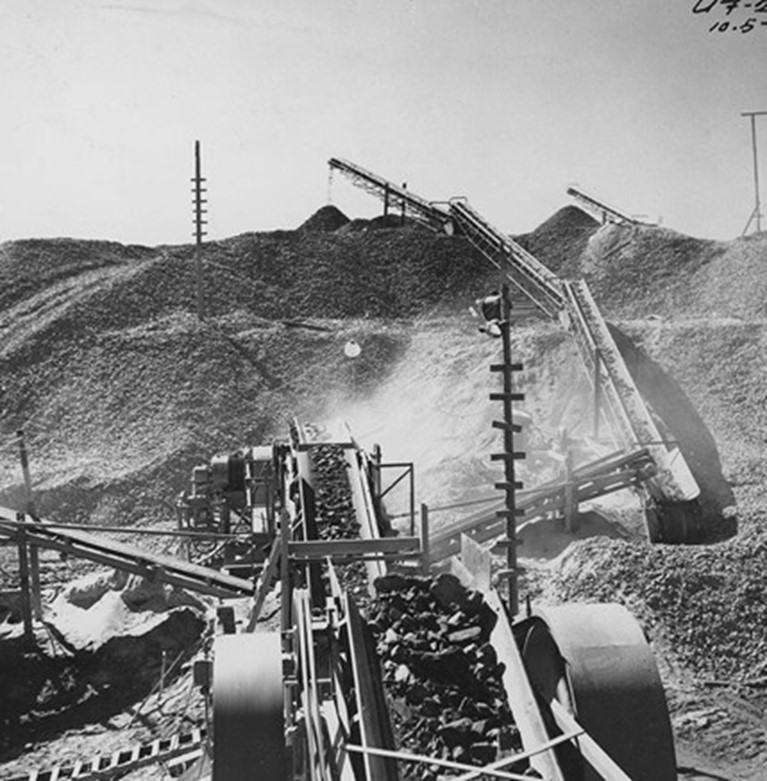
View of the scale of the excavations. Photo: Fortum Oyj photo archive (U7 256 - 10.5.1956).
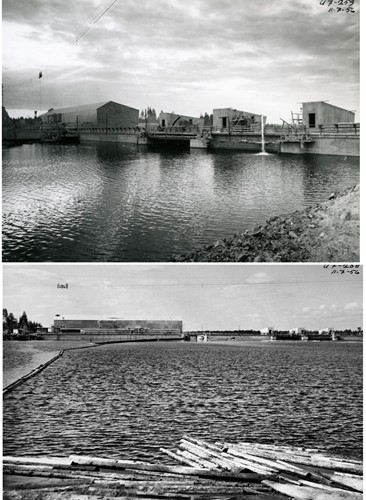
Two views above the power plant and dam Photo: Fortum Oyj photo archive (U7 259 and U7 258 - 11.7.1956)
Language problems
[I think here I should give some explanation of the language problems and how we tried to overcome them. With more students arriving conversations became more difficult and a sort of Pidgin English developed between the four of us and the people on the site. The position with us was this: John – From England - English with a little German and French, Marko – From Yugoslavia - German with a little English, Robert – From France - French with some English, Willie – From Austria - German with some English
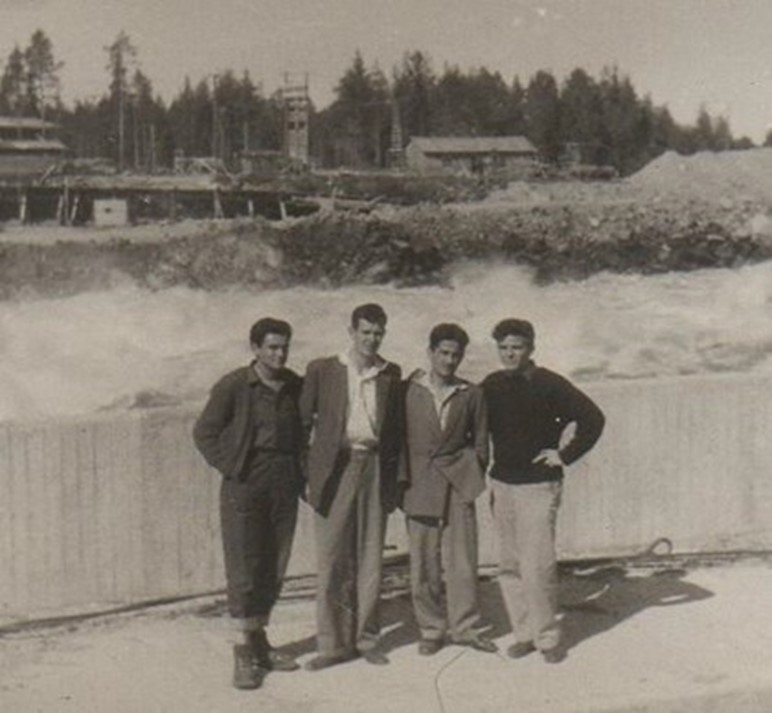
Left to right Robert, me, Marko and Willie. Mr John Woodman´s personal photo collection.
As for the Finns we came into contact with, because in the south west there is a Swedish population, Swedish was taught as a second language. German had been taught as a third language although schools were starting to teach English instead. Because of this quite a number of Finns were able to talk with us in German. There were only a few who had any English and only two, Rayner and the engineer Mr Liimatainen who was in charge of us, at all fluent.
With the Finns, many of whom spoke no other language, there was sign language and my very small English/Finnish dictionary. I still have it and it measures 55 x 75 mm. It surprised me how quickly you can pick up gestures and sign language when that is all you have. I could also point at words in my little dictionary and show the equivalent.]
The French student, bilberries and cricket
Wednesday 1st August 1956
Dear M. and D.,
Thank you for your letters which I received today. The French student will come here, after all, in a fortnight so the books will come in useful. My head is so full of German at the moment that I doubt that I will be able to think in French.
Every day we eat loads of bilberries which grow in abundance near here round the huts.
Thank you very much indeed for the news about the test match; it seems very good so far.
I must stop now if I am to catch the post.
Cheerio, John
Post at last and a visit to Oulu
Sunday 5th August 1956
Dear M. and D.,
Much post has come this week and I think that I have now all I ought to have, i.e. Insect stuff, address book and Y. H. A. (Youth Hostels Association) book. The letters get here so much quicker than newspaper packets so please would you continue to cut out and enclose bits.
This weekend I have been to Oulu with Marko in a chap’s car and we had a good time looking round the city of some 50,000 bods. The picture is of the highest structure in the place which we climbed and had a very good view. The enclosed picture does not give much idea of its height which is 51 metres.
I will be glad when I can read about Jim Laker’s feat of 10 wickets again. Not much else has happened here this week Robert, the French student, should come tomorrow. By the way insect cream received instant use as Willie had been out in the woods and got rather badly bitten.
Yours, John
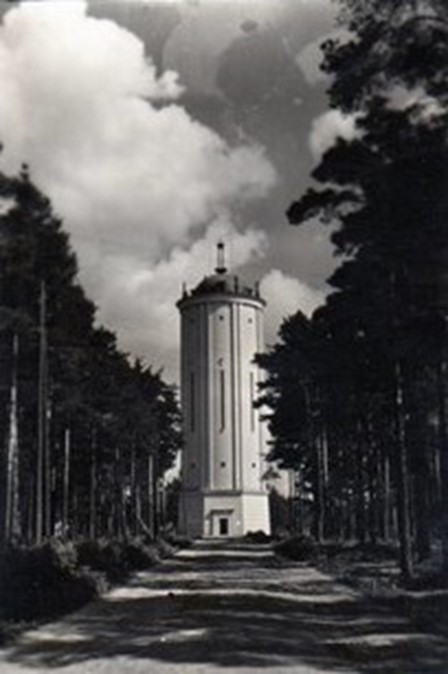
Oulu Tower. Mr John Woodman´s personal photo collection.
Finnish Greeting
[One day the three of us were in one of the site offices and men were coming and going. This was before Robert had arrived. We greeted them by saying “Hyvää huomenta” that is “good morning” in Finnish. One of them said to us that it was usual in working situations like here to use a less formal greeting. Having practised this new greeting a few times he left. When more men came in we used the new greeting. After a few minutes someone came in and then left but rushed back and said something to the person in charge who just had time to tell us that the greeting could not be used when greeting a woman as it did not apply. One of the main office secretaries immediately came in with an urgent message. We could see the relief on the men’s faces when we reverted to our previous greeting. Some 64 years later this is one of the few Finnish phrases that I remember!]
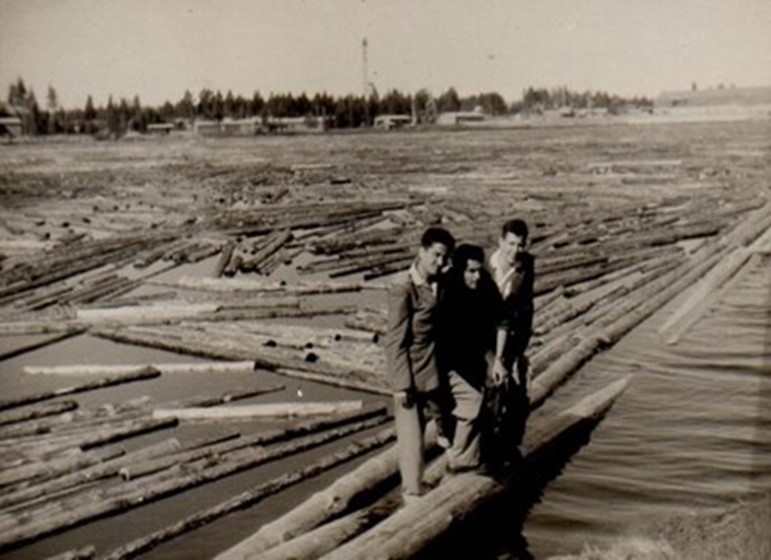
Marko on the left, Willie in the middle. Timber floating in the sea near Oulu. Timber is the most important industry here. Mr John Woodman´s personal photo collection.
Power stations, going on a trip and saunas
Thursday 16th August 1956
Dear M. and D.,
I have run out of writing paper but still have plenty of envelopes so letters in future will be written on this. [The Paper had lines and was torn from an exercise book]. Officially, I have two weeks more work before I come home but on Saturday we are going for a little trip. Please get out a map. We start by going to Oulu. I will send you a card from our destination. I think I will leave Utanen on 28th August but nothing is certain. I have decided to buy a good camera - it will use up some Marks and anyway cameras are much cheaper in Finland. I don’t know how much duty I will have to pay on it but I think it will still be much cheaper. I have with me a camera expert from Austria and he will advise me in my choice.
I have thought up some things that I want for my birthday, (my 21st), football boots, left hand batting gloves, wrist watch and a drawing board. I also think it would be good to have French and a German novel to read.
On Sunday we went for a trip round all the six power stations of Oulujoki Oy. It was very interesting and the weather was very good. The colour of the lakes is wonderful when the sun is shining and the sky is very blue here. I don’t know why, but lakes always fascinate me much more than the open sea.
I cannot remember whether I thanked you for the maps but they have arrived.
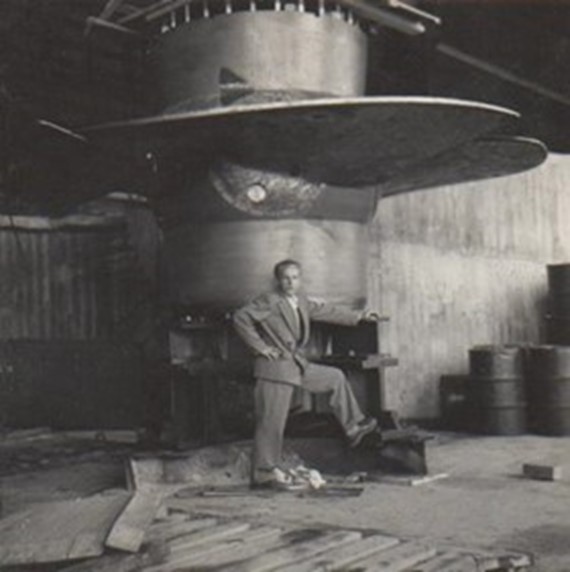
One of the three Kaplan turbines. Mr John Woodman´s personal photo collection.
Details about Saunas
You undress and then walk into a washing room where people wash after or in between sessions in the sauna. Here you collect a bowl and fill it with cold water. Next you go into the sauna itself. It is a room with tiers of seats stretching from the floor to the ceiling. The room is very dark with two foot square windows and a dim lamp. The higher one sits the hotter it is as steam rises to the ceiling. It is considered rather curious though if you do not sit at the top and there is much laughter if somebody takes a lower seat because of the heat. In one corner is a stove-like contraption into which you pour water where it is immediately vaporised. After about ten minutes it is time for a cold shower which is in the sauna room and after another five minutes you go out and wash, pouring large quantities of water over yourself. After washing you return to the sauna room for about five minutes and then go and dry and get dressed.
I hope the weather is a little better now for you.
Cheerio, John
[Larger houses had their own sauna. The engineer in charge of us, Mr Liimatainen, had one and he invited us to his house to use his. It was in a separate hut beside the river and was to a higher standard. Instead of a shower after the sauna we bathed in the Oulujoki River. We had a good evening meal there afterwards.]
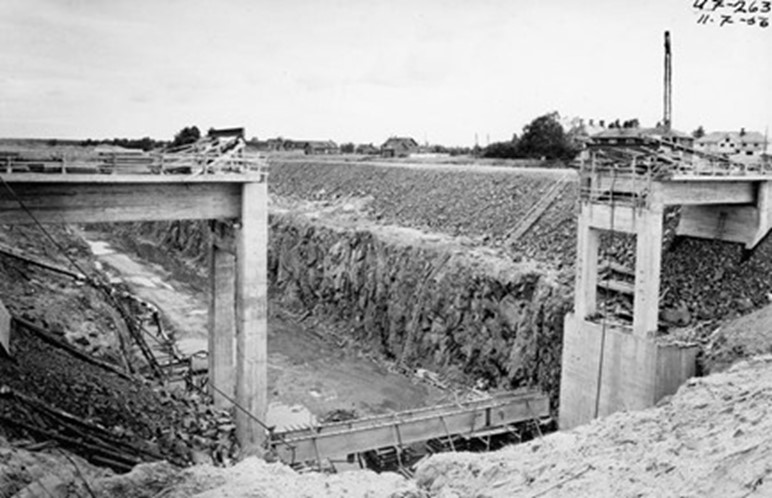
Looking down into the tailrace. Photo: Fortum Oyj photo archive (U7 263 - 11.7.1956)
Power plants on the Oulu River
On Sunday 12th August, when we went on the tour of the six power stations built by Oulujoki Oy, we were given a leaflet giving us details of the whole project. I am quoting from it as follows:
‘The power plants of Oulujoki Oy
The water course of the Oulu River (Oulujoki) is the fifth biggest in Finland, its catchment area being nearly 23,000 sq km. The mean discharge of the river is 240 cubic metres per second, and the central basin, Oulu Lake (Oulujärvi) comprises 900 sq km. The Oulu River, which flows from Oulu Lake, to the Gulf of Bothnia (Pohjanlahti), has a total length of 107 km. The total head of 122.5 metres has been terraced in seven power plants of which Oulujoki Oy has built six.’ These are, in the order that they were built, Pyhäkoski, Jylhämä, Pälli, Nuojua, Montta and Utanen. Refer to map on page 59.
‘The company was established in the spring of 1941 to develop the water power of the Oulu River, with the exception of the Merikoski rapids, which are owned by the city of Oulu.
‘Utanen
‘Utanen, the last power plant on the building schedule of Oulujoki Oy, will be completed in 1957. The total head of Utanen rapids, 15.7 metres, has been connected by a tailrace, 12 km in length. The construction of the plant was started in 1952. The effect is 55,000 kW and the annual output of energy 280 million kWh. Earth-moving at Utanen tailrace has been carried out on an extensive scale, more than 7 million cubic metres of earth and rock having been removed.
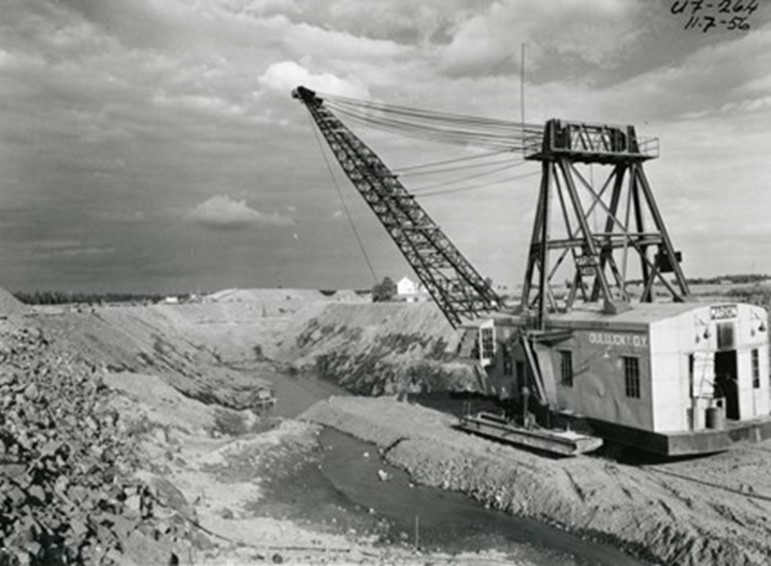
The largest crane working in Scandinavia. Photo: Fortum Oyj photo archive (U7 264 – 11.7.56)
‘Regulation of the watercourse
By regulating the lakes of the watercourse, a total reservoir volume of 4,600 million cubic metres will be available, 3,200 million of it being already so. Two-thirds of the total annual amount of water of the Oulu River can be stored in the lake reservoirs and thus, from the point of view of the power economy, complete regulation of the watercourse can be obtained.’ This ends the quotation from the leaflet.The catchment area of the Oulu river system covers a very large area in the north of Finland from Oulu on the Gulf of Bothnia in the west to the Russian border in the east. Other named rivers feed into the very large lake, Oulujärvi, on which more power stations have been built as shown in the map. This report is based entirely on a report by Oulujoki Osakeyhtiö. It is here with the permission of Fortum Power and Heat Oy.”
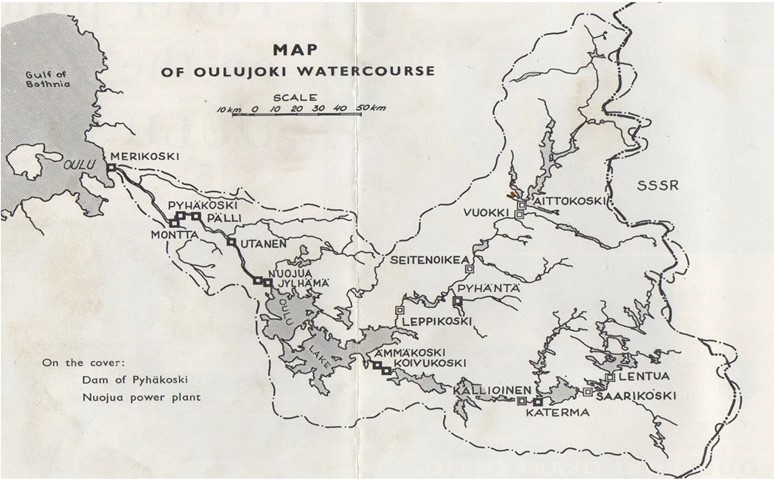
The catchment area of the Oulu river system.
Our return from Lapland and preparations to leave Finland
[As we had only just arrived back at Utanen the previous letter did not complete the story of our journey because I wished to catch the post.]
Thursday 30th August 1956
Dear M. and D.,
Here begins the last letter from Utanen. Let me first finish the story of our journey. Robert and I said “Goodbye” to Willie and went to the Youth Hostel where we met many interesting people. There were two Finnish, two Norwegians, two Italians, two French and a German. After a very enjoyable evening, in the morning we left town for Karigasniemi, some 20 km away, with the two French people.
The day was fine and we had a very pleasant walk. We reached Karigasniemi in Finland at about 5.00 pm and as we had an hour and a quarter before the bus went to Ivalo we went into a café and had a cup of coffee. We had just finished our drink when we heard the noise of a bus and looked out of the window to see our bus rushing by. We dashed out of the café but it was too late. Then we remembered that Finnish time is one hour in advance of Norwegian!
The four of us as the two French people were coming with us were talking by the side of the road. Suddenly a car came out of a side way which was empty apart from the driver and going in the direction of Ivalo. Robert and the two French people jumped into the road and blocked the car’s way. We asked him if he would catch the bus for us. We were all talking very excitedly and loudly but I think he understood anyway and we all climbed in and off we went.
In half an hour we saw the bus stopped by the side of the road with all the occupants standing round in the road. The bus had knocked down a reindeer which was sitting by the side of the road. After a consultation among the people present one man took out a sheath knife and killed it. For me it was a rather horrifying experience. Afterwards the man asked us to return to his car and we continued to Ivalo in it where he dropped us off at the bus stop.
[As I needed to go to the loo I went into a hotel. There were lots of people milling about in reception. I spotted two doors which looked like what I wanted. When I walked over I found that each door had a picture of a Laplander in their very colourful costumes. The problem was I did not know which was which, so my only option was to wait for someone to go in or come out of one of the doors. I had to wait for what seemed a very long time but was probably three or four minutes. Then a woman went in through one of the doors so I used the other one. On coming out I had a very close look at the signs but was none the wiser.]
We did not have to wait long for the bus. It was driven very fast through the night to Rovaniemi and then on to Oulu which was reached about 12.00 midday last Friday. [(24th August) We got the bus to Utajärvi and then walked the two and a half miles back to Utanen.]
[Somewhere on our journey I bought a set of reindeer antlers which I still have and also a packet of cheap cigarettes. The cigarettes were nothing like the ones you could buy in England. It was a packet of twelve, each only 6 mm diameter and 75 mm long with half the length a filter. There are still nine left! These are the only physical mementos of my time in Finland.]
Now for what is with me now. I leave Utanen on Saturday 1st September. I do not know exactly when I arrive in Dorking but on Sunday 9th or Monday 10th most likely. I will keep you informed as I travel home. Anyway I come to Dover and come to Dorking Town (now called Dorking West) via Folkestone, Tonbridge and Redhill. I arrive in Dover early in the morning, about 8.00 am I think, but you must wait a little for more exact information.
It will be good to be home after being away for so long. I am looking forward to seeing you very much. I can’t think of anything else to write so you must wait until you receive a card from my journey.
John
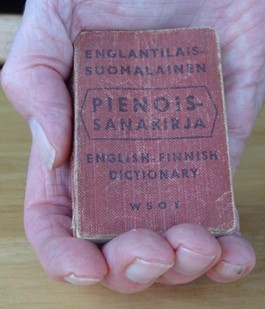
My very small dictionary was only 75 mm x 55 mm. I could point at a word in English and provided the person could read the tiny print, get a response. However, it was only one way as there was no Finnish to English section. Mr John Woodman´s personal photo and postcard collection.
The journey back to England
On my return from Lapland I had one more week at the power station. I had planned the journey home before our trip to Lapland and bought the tickets in Oulu. The first step had been to decide how to get back to Helsinki. Having studied the leaflets I’d been given at the travel agents there were really only two possibilities. Either to return to Helsinki the way I travelled up or head south-east. I had looked at the map I had with me and going south-east looked more interesting. The area close to the Russian border has more lakes than dry land so that’s the way I went taking three days to get to Helsinki. After that I had decided to visit the capitals of the three Scandinavian countries by travelling at night and visiting them during the day.
A problem was how to cope with my case. It was quite large and it would be tiring carrying it far by the handle. I was given some thick rope at the site and made a harness so that I could carry it on my back. I was very pleased with it and it worked well. The set of antlers I’d bought had to be fixed to the top of the case with the bottom of the case against my back. It stuck out quite a long way so I had to be careful, particularly when getting on and off buses and trains. I did get a few comments and odd looks on my way home.
I said “goodbye” to everybody and thanked the people working at the power station site. I especially thanked Mr Liimatainen and Rayner Tuovinen who had been with us much of the time for all they had done to make it such an interesting experience. I left early on 1st September. The first stage was to walk to Utajärvi station. It was a lovely sunny morning and I was really looking forward to my trip. There weren’t many people on the train so I could change from side to side in my carriage to look at the scenery. It was not long before we reached the large lake Oulujärvi (Oulu Lake) which fed the Oulujoki (Oulu River). The deep blue colour of the water was very striking. There were very few settlements but much forest along the way. We were told that more than two thirds of Finland was covered by forest. Not surprising then that timber was a major export.
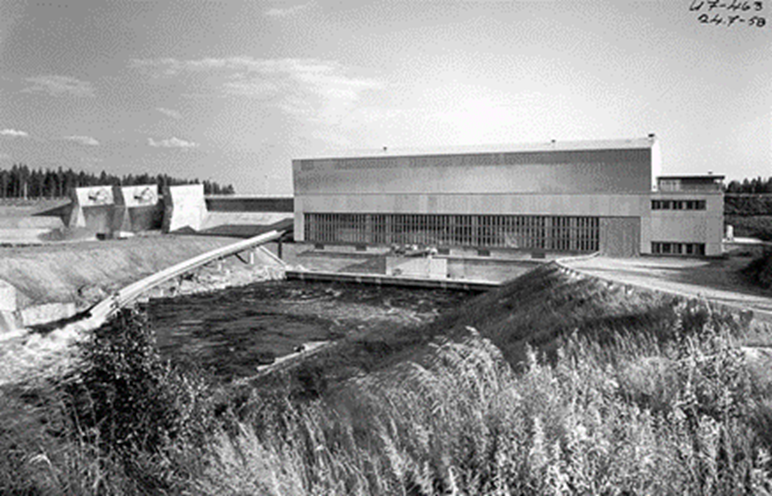
Dam on left of power station with log chute in between. Photo: Fortum Oyj photo archive (4.7.56)
Utanen hydropower plant
Utanen hydropower plant, completed in 1957, is located at Utajärvi. The output of the power plant is 58 megawatts and the head is 15.7 metres. There were three Kaplan turbines. Average annual production covers the annual electricity use of about 13,000 households with electric heat.
History
Preparatory works for Utanen started in late 1952 by building temporary and service buildings. The actual residential area was built later in the 50s. Construction of the power plant started the following year. The north side of the dam was finished at the end of 1953 and the southern side soon after this. The sets of machineries were ordered from two Finnish companies, turbines from Tampella and generators from Strömberg.
Earthworks for the tailrace started in the spring of 1954. Excavations for the canal were extensive. Almost 4 million cubic metres of rock had to be removed. Nine diggers, more than ten bulldozers and 30 heavy dump trucks were assigned to the task. It turned out to be the largest earth moving job in Finnish history. People of Utajärvi had to stay inside during rock blasting and Oulujoki Power Company paid them 100 Marks per blast. The power house, designed by Aarne Ervi, has an in-situ concrete frame. Facades were constructed out of precast panels. In May 1956, water was released to the reservoir. The tailrace was finished at the end of the year and the first set of machinery was connected to the power grid on 19th November 1956. Because of the long tailrace landscaping went on for decades.
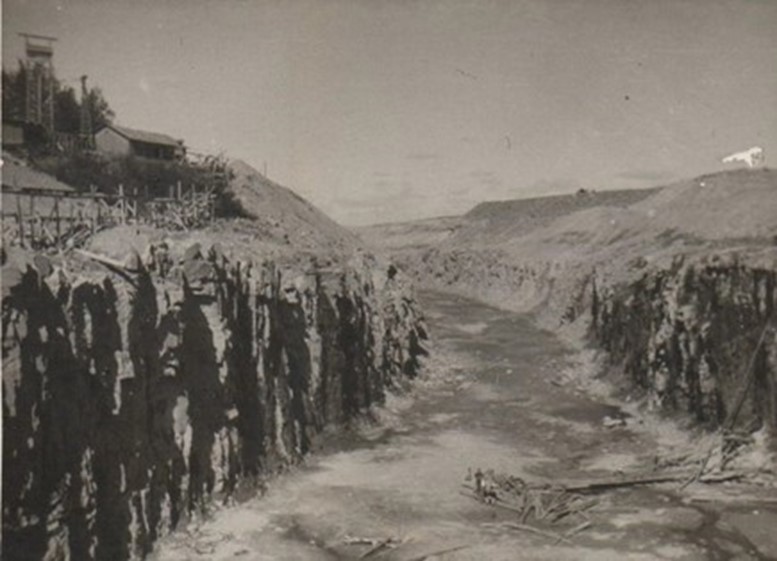
The tailrace. Mr John Woodman´s personal photo and postcard collection.
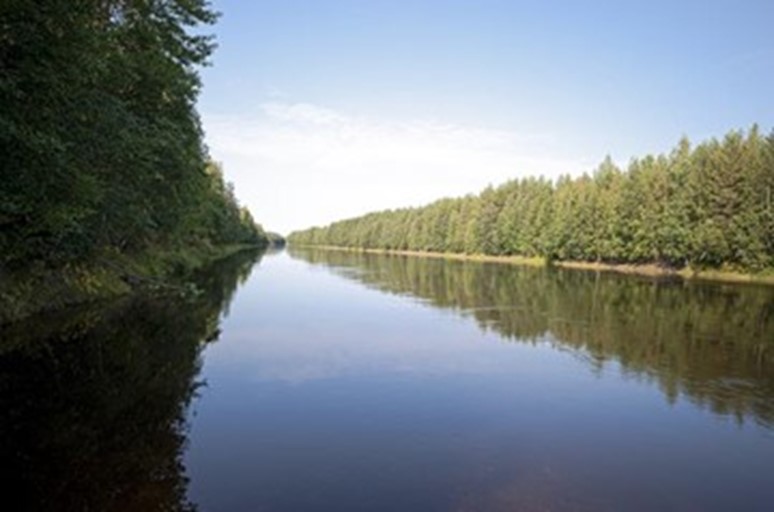
The tailrace after landscaping. Photo: Fortum Oyj photo archive (DSC 4520 w)
The second set of machinery was connected to the power grid late in 1956 and the third one in the summer of 1957. Electricity production started in autumn 1957. Utanen has a maximum capacity of 58 Megawatts, which makes it the third largest power plant on the Oulujoki. After Utanen was finished the main channel of the Oulujoki was completely harnessed to electricity production.
Early History
The idea of using the water power of the Oulu River really began at the beginning of the twentieth century. In 1906 the Senate set up a committee to explore and examine suitable power resources including among others the Oulu River and particularly the Pyhäkoski rapids which had the greatest drop. Interest continued through and after the First World War. In 1930 field work was carried out along the whole river valley and in 1935 the Governor of Oulu district proposed that technical and economic research be done so that construction costs could be estimated and how and where the energy could be sent. This was followed up and as a result it was hoped that a proposal could be made for a power station at the Pyhäkoski rapids. Here the head was the highest at 32.2 m. In order to move on a power company was set up in the spring of 1941.
Work begins
Immediately, after the set-up of Oulujoki Oy, work began on the building of the power station at Pyhäkoski. At the same time it was necessary to build a completely new community in the wilderness of north Finland. As this was being done investigations were continued to develop the building of power stations along the whole of the Oulujoki (Oulu River) from its source at Oulujärvi (Oulu Lake). The total head was divided among seven power stations six of which were built by Oulujoki Oy.
All the power plants in the Oulujoki are located in the river bed. The power station and the regulation dam are placed side by side in the same line so that a headrace is unnecessary. It was decided to concentrate the total head using modern techniques on as few power stations as possible. As the rapids are gently sloping, long tailraces have been built especially at Utanen which will have a tailrace of 11 km.
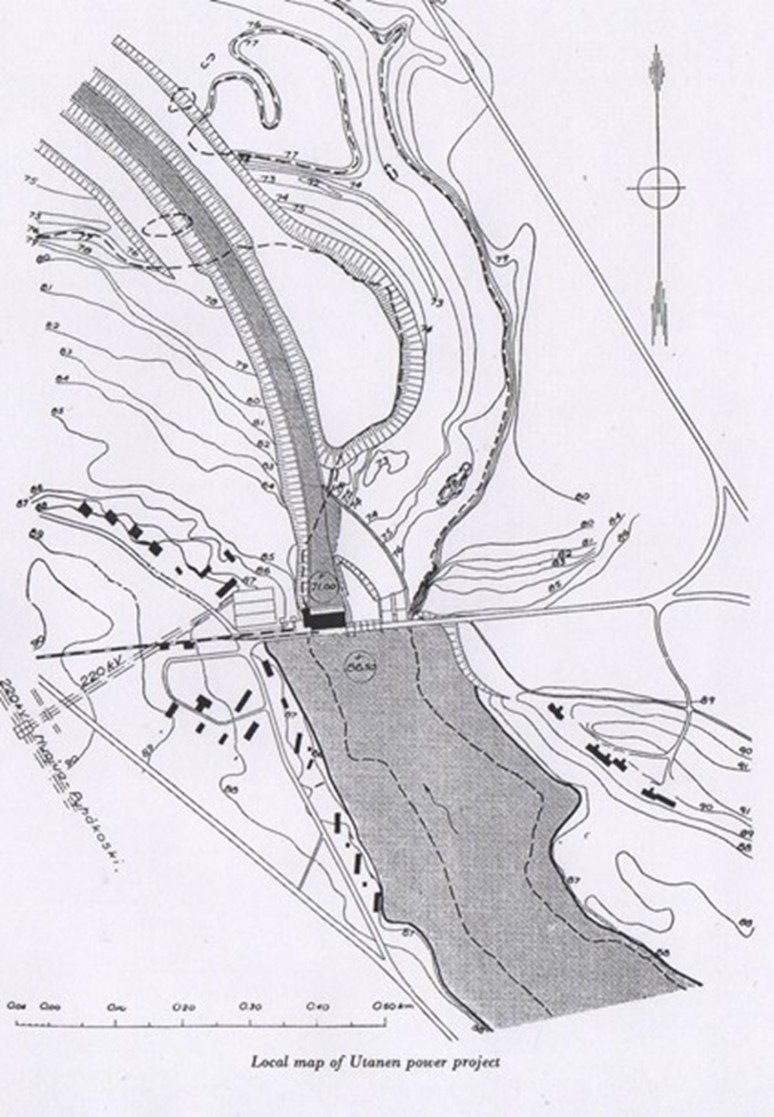
Local map of Utanen power station Utanen Power Plant. Source: Power on the Oulu river (1953) p.23
With ever increasing demand for power in the autumn of 1952 preliminary works were started at Utanen rapids. This was the last of the six power plants being built by Oulujoki Oy. The power house is located on the southern bank of the river and the regulation dam will extend across the bed of the river on the northern side of the power house. The dam is designed as a concrete gravity dam. Two spillways have radial gates situated in the regulation dam, which also has a log chute. This power station is expected to be ready at the end of 1956. Five million cubic metres of earth and rock will need to be removed. For this and other similar work the company has obtained a drag-line, Model Marion 7400, supplied with a six cubic metre bucket.
In designing the six power plants Oulujoki Oy had a considerable amount of hydrographical information together with research into the nature of the watercourse and soil. The Architect Aarne Ervi was responsible for the design of all six power stations.
Power Transmission
As the main consumer centres of energy are located in southern and central Finland, high voltage lines at 220 kV had to be provided. The first of these lines was from Pyhäkoski to Hikiä, in the south and not that far from Helsinki, a distance of about 500 km. Another 220 kV line is being built with a starting point of Nuojua the next power station upstream from Utanen. In addition to these lines the building of 110 kV and20 kV lines are partly projected and partly in the course of erection.
This report is entirely based on a report by Oulujoki Osakeyhtiö and dated in Helsinki June 1953. It is here with permission of Fortum Power and Heat Oy
Oulujoki Power Plants and Communities
Built in the middle of the wilderness of northern Ostrobothnia and Kainuu, the hydro-electric power plants along the watercourses of the Oulu River, together with the communities connected to them, form a totality that was realised by means of modern architecture and building techniques, yet modelled on early industrial communities. The harnessing of the watercourses of the Oulujoki River was the largest integrated construction project in post-war Finland intended to ensure energy production.
The work commissioned by Oulujoki Oy was a long- term and comprehensive assignment among the works of Aarne Ervi and his architect’s office from the 1940s to the 1960s. A total of seven power plants were built on the Oulu River, six of which were designed by Ervi: Montta, Pyhäkoski, Pälli, Utanen, Nuojua and Jylhämä. Additionally, three power plants were built at the headwaters, along the Emäjoki River, which begins at Suomussami: Seitenoikea, Aittokoski and Ǟmmä, as well as the Oulu Pikkarala substation and transformer substation. The first and largest power plant was Pyhäkoski and the Leppiniemi housing area linked to it, the construction of which began during the Interim Peace in 1941. The complex was finally complete in 1963 when the new community hall in Leppiniemi was taken into use.
Ervi, who had set up his own office in 1938, worked on Finland’s reconstruction projects, in particular tasks concerning standardisation, but also on Oulu’s planning projects at the turn of the 1940s and 1950s. The construction along the watercourses of the Oulu River was the realisation of Ervi’s thinking regarding regional planning.
The construction of hydropower plants along the Oulu River provided Ervi with a concrete opportunity to test and apply architectural ideas at all levels, ranging from regional planning to the smallest building details. The layout of the power plant communities followed, on the one hand, the modernist planning ideologies of low density, adapting to the surrounding nature and terrain while also, on the other hand, the early industrial communities based on the hierarchical structuring of the area. The architecture of the buildings supports the town planning ideas. The power plants together with their surrounding service buildings are simple and monumental, whereas the residential areas form a lush park- like environment. The architecture of the residential areas is small-scale, carefully detailed and of a high quality both technically and architecturally. The housing construction forms a topological system, which was applied in all the power plant areas. In all his design tasks, Ervi emphasised the development of building technology, standardisation and industrial prefabrication.
The power plants built for Oulujoki Oy are nowadays owned by Fortum Oy and still produce electricity. The housing areas have been sold to private owners. The protection of the areas has been secured by means of the town planning regulations, as well as the guidelines for building and repair methods linked with them. The totality is still well preserved and the communities are vibrant.
Text by Helene Hirviniemi (http://en.docomomo.fi/contributors) Docomomo Suomi Finland
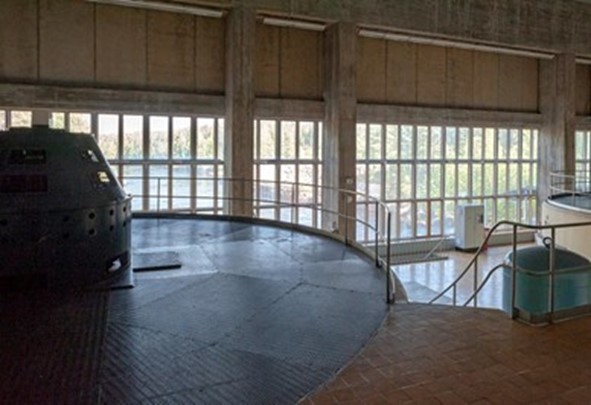
Inside the Utanen power station. Photo: Fortum Oyj photo archive (DSC 4484 w)
The importance of the whole project
Covering the years from 1941 to 1963 seven power stations were built along the Oulujoki (Oulu River) from the Oulujarvi (Oulu Lake). This was a sparsely populated area in northern Finland so besides the power stations themselves there was a need for planning the housing of the communities which would be needed to run the plants once they were built.
The project was the largest integrated one in Finland at this time and six of the seven including the one at Utanen were designed by Aarne Ervi for Oulujoki Oy. The building of the first one, which was the largest, began in 1941. This was a great opportunity for Ervi to bring his new ideas for the construction of industrial plant down of the planning for small residential urban communities. His new modern ideas were a great success for which he received national acclaim.
Helena Hirviniemi’s piece in a previous chapter above gives an excellent overview of the whole project. While I must have been told verbally, I had nothing in writing about the communities or about Aarne Ervi the architect of the project. The details about the six power stations and the catchment area of the Oulu River system were given to me in a leaflet in 1956.
Since my time in Finland I have read about its history and especially of what happened during the Second World War. I am astonished that such a large project was started during that time when it is not an exaggeration to say that its very existence as a free country was under threat.
I hope that the details of the Oulu power stations and the fact that the communities to service them had to be built at the same time will convince you that this is a project worthy of World Heritage Status.
Reflections on my travels and my time in Finland
So what are my thoughts now over sixty years later? I am extremely grateful for the opportunity I had then to travel to Finland. At that time, not very long after the war, travelling abroad was not that common and it took much longer. It took five days to get to Utanen and because of two diversions eight to get back.
So here in 1956 four young men met whose countries had all been through very difficult but completely different times – France, England, Yugoslavia and Austria. We enjoyed each others’ company and our shared interest in the engineering involved in the building of a power station. The lack of a common language did not seem to be a problem and did not detract from the whole experience.
When I got to Utanen I was told I would be sharing accommodation with a number of ‘housemasters to use the literal translation - a superior type of foreman’ as I wrote in my letter. I’ve since tried to find another word which we would use. In English a housemaster is a teacher, particularly in a boarding school, who is responsible for a group of children in a dormitory or house. In 1956 most Finns we spoke to were more familiar with German than English so I looked in my German/English Dictionary. However the literal word in German is ‘hausmeister’ which means ‘caretaker’, that is someone looking after a building. In English we use the words ‘manager’ and ‘supervisor’. Both these words would normally be qualified as, for example, ‘works manager’ or ‘office supervisor’. Alternatively, a phrase such as ‘Section Leader’ or ‘Engineer in charge of …’ might also be used. The building I was in had 16 single rooms. Other accommodation buildings were of a similar size.
The site was a happy place and the workers were obviously enthusiastic about what they were doing. In their spare time we were invited to join them with games of handball and darts and to have coffee. My dismissive view that I’d rather swim in the river than have a sauna was greeted with surprise and led to us students being taken to have one three times a week! Two men would come and collect us and they appeared to have a rota for this task. In fact I really enjoyed the saunas.
As to be expected as a young man abroad in a strange country, it was the things that were different that were written about in my letters home. There were twenty four hours of daylight when I arrived and I found this quite difficult to adjust to. The buildings I described as ‘superior huts’. I’ve wracked my brains but I don’t think I’d seen more than one or two wooden houses previously. Of course in Finland it was the obvious choice.
One thing that might surprise people in Finland was when I wrote ‘The food here is quite like home. They drink milk at all their meals and have potatoes cooked in an approved fashion.’ I cannot tell you now what I meant exactly by ‘an approved fashion’. At home we mostly had boiled, mashed or roast potatoes. The previous year I had stayed with a family in Germany for three weeks and there was quite a lot I did not like. Of course, you cannot judge one family’s meals as being typical. Meat was either eaten raw or, to my taste, well undercooked. One day I was offered ‘bacon and eggs’ which I accepted. I was asked if I liked it and replied in what I thought was a tactful way. “In England we usually cook the bacon a little more.” “Cooked!” they exclaimed, “It’s raw.” The bread we had was always on the stale side. One day I went into the kitchen and smelt bread which had just come out of the oven. I said hopefully “Are we having some of it for tea?” But my hopes were dashed. “No” said the mother “we leave it for three days as it’s not a good idea to eat it when it’s fresh.” On another occasion I was offered a glass of milk which I accepted only to find it was sour. However, I had no complaints about the food in Finland.
In many cases I have converted prices from Finnish Marks and £ s d to £ p. I’m not sure how useful this is as it is so hard to understand the value of things after such a long time and where there has been so much inflation.
I took the decision to type up the letters exactly as they were written and to leave nothing out. Once you start doing that where do you stop? I doubt that many of you reading this are interested in how Surrey was doing in the County Cricket Championship in 1956! When I started to write this account I was disappointed that I had so few photographs. However, now with the photographs I’ve had sent to me from Finland and a few others which I found at home I am content. Although, it was only two months in my long life it has been a pleasure for me to recall this memorable and happy time.
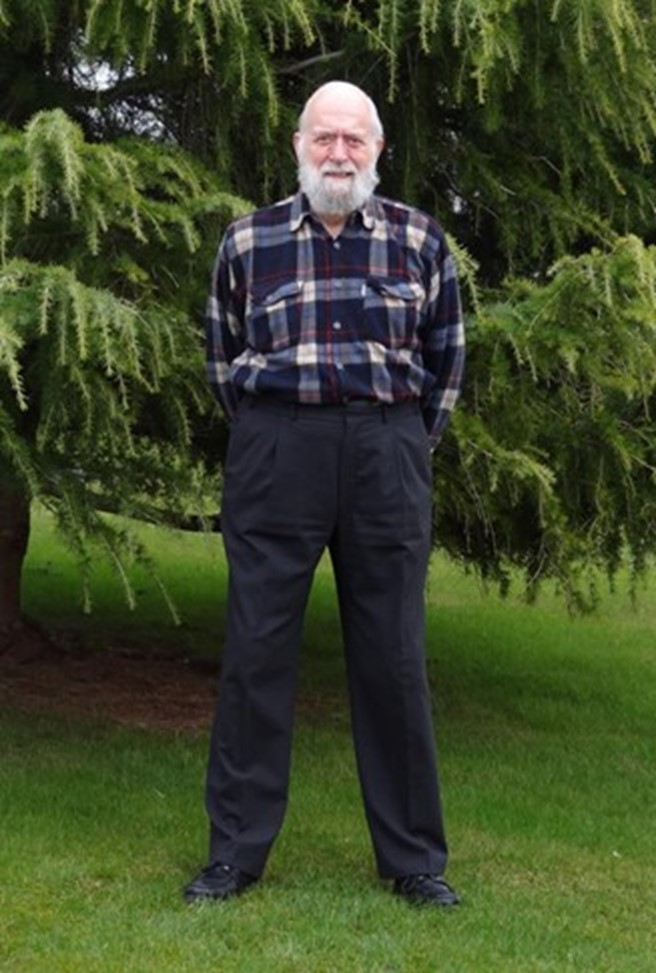
In my garden in Penrith. Photo: Mr John Woodman´s personal photo and postcard collection.